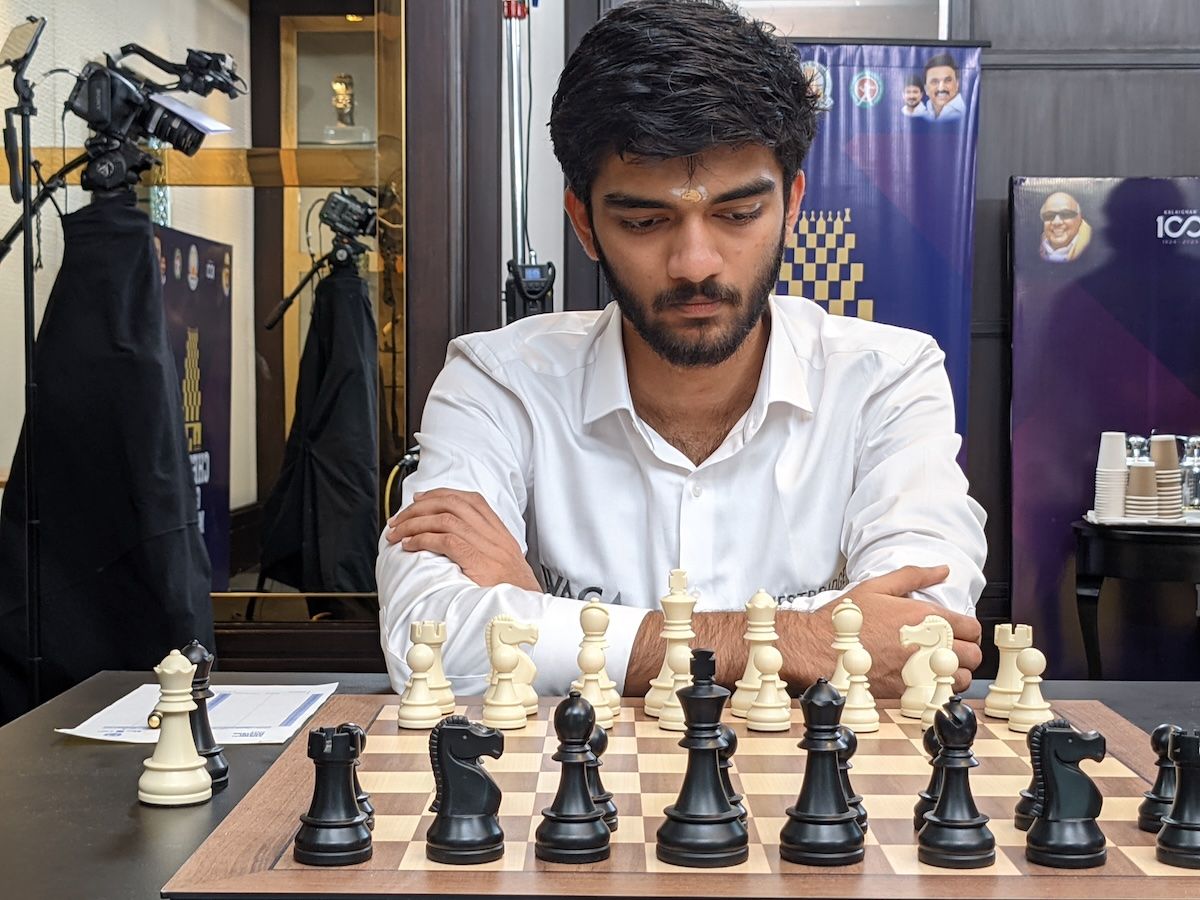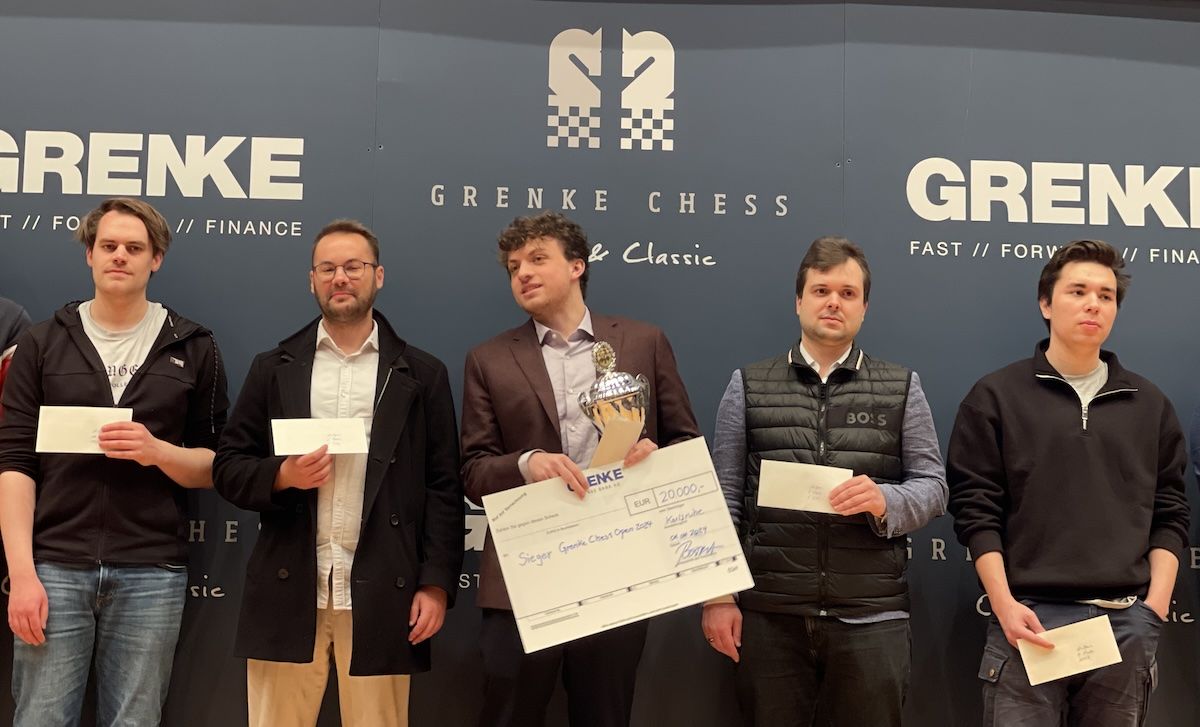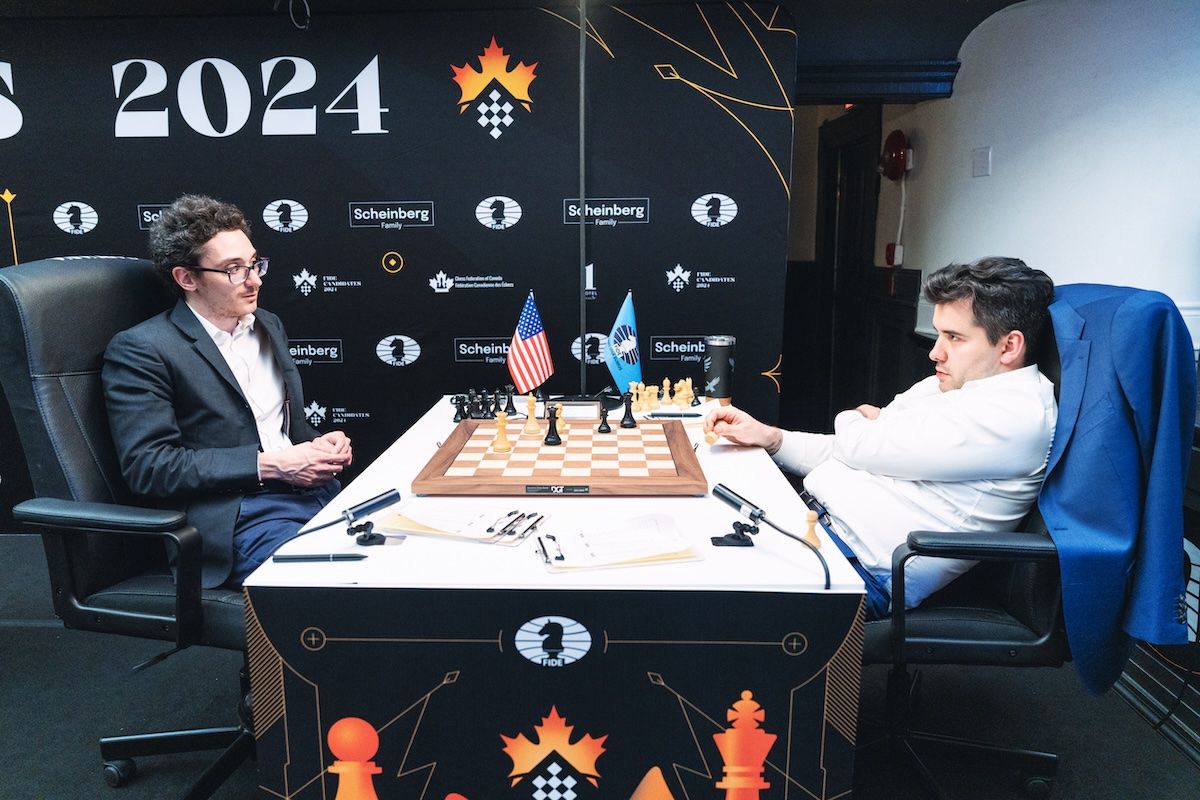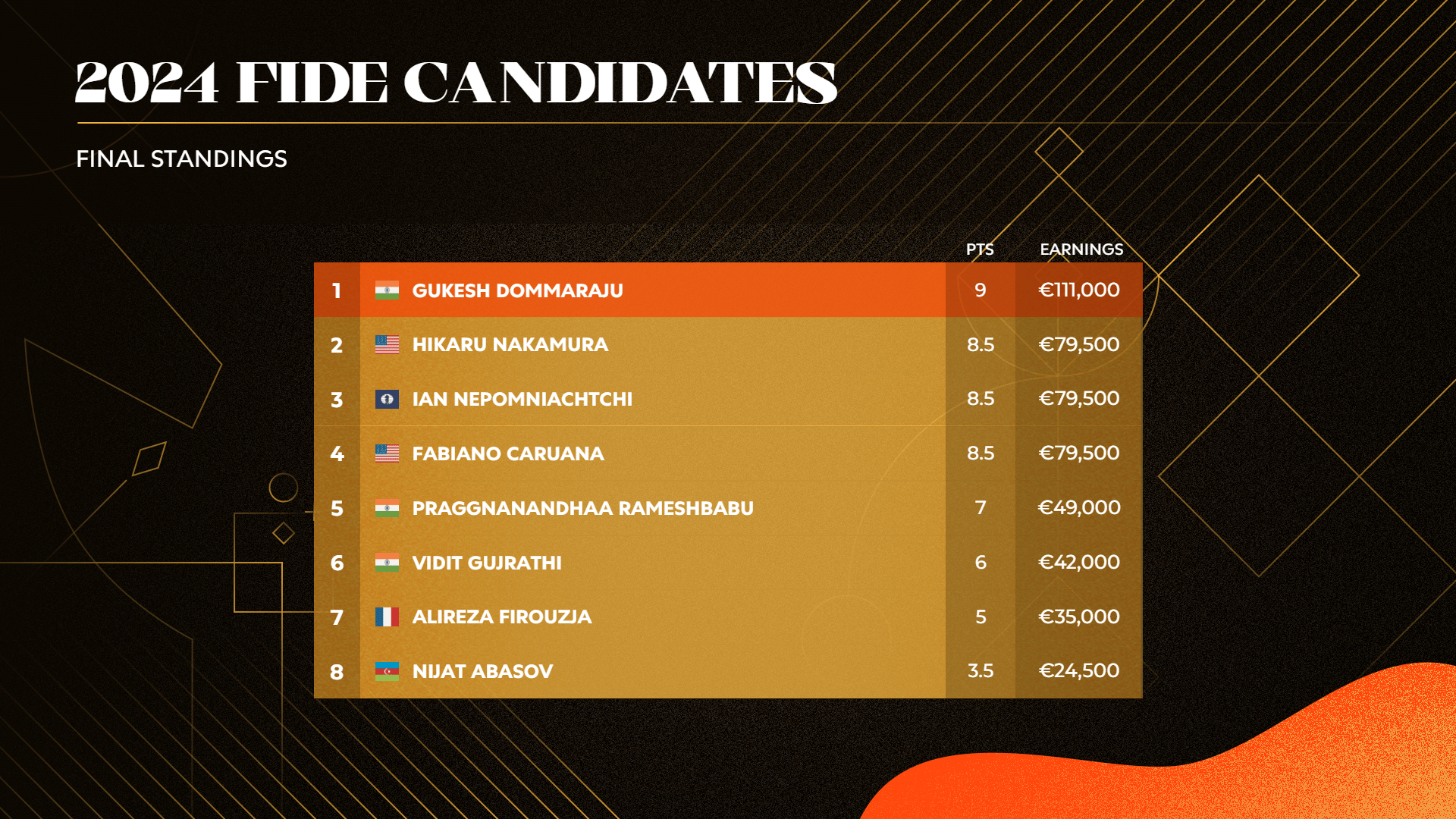
Giri, Caruana, Aronian Criticize FIDE Circuit
GM Levon Aronian recently wrote, “the FIDE Circuit is kind of a joke,” with GM Anish Giri replying to describe it as “completely broken.” 2023 FIDE Circuit Winner GM Fabiano Caruana, described the system, which will determine two out of eight places in the 2026 FIDE Candidates Tournament, as “the dumbest thing I’ve ever seen.” What do they see as the issues?
GM Gukesh Dommarju has just won the 2024 FIDE Candidates Tournament to earn a world championship match against GM Ding Liren, but the race to qualify for the next Candidates in 2026 has already begun. One part of the qualification system burst into the spotlight when Aronian tweeted a complaint, and was soon backed up by Giri.
Yeah, it's completely broken. Enough to see how they allocated points to Wijk masters and challengers.
— Anish Giri (@anishgiri) April 29, 2024
Before we get into the details, let’s look at the basics.
- What is the FIDE Circuit?
- The American Cup
- Tata Steel Chess
- GRENKE Open
- FIDE Candidates
- Norway Chess And The World Championship
- Democracy, Exploitation, Or Economics?
What Is The FIDE Circuit?
The FIDE Circuit is a points system devised by the World Chess Federation (FIDE) for measuring tournament performances across a year, with a player’s top seven performances added together to make an overall score. In 2023, a maximum of five performances was taken into account, with Gukesh using this path to qualify for the Candidates (he was second to Caruana, who had already qualified via another route).

This time the circuit will be run in both 2024 and 2025, with the winner each year qualifying for the 2026 Candidates, so that two of the eight spots in that incredibly important event will come from the circuit.
The American Cup
This year’s American Cup, won by Aronian, was a formidable high-stakes event featuring the world numbers two, eight, 13, and 26, but it won’t count toward the FIDE Circuit since more than 50 percent of the players—in fact 100 percent—came from the same federation. The one exception is for national championships, so the U.S. Chess Championship will count.
That restriction on federations applied in 2023 as well. FIDE CEO Emil Sutovsky explained that it was partly to counter how China had organized events for Ding to qualify in 2022.
There must be a difference between established event with world class players like the American Cup , and a swiftly stitched “single performer plays” When you say Wijk and Candidates are double you are being dishonest, Gukesh got 26.94 , Hans got 20.82 for Grenke Open.
— Levon Aronian (@LevAronian) April 29, 2024
Tata Steel Chess
The annual January chess festival in Wijk aan Zee, the Netherlands, is the curtain-raiser for the chess season, but the FIDE Circuit points given after the action was over received criticism.

At a glance you can see that GM Wei Yi, who won the Masters, scored the highest number of circuit points, as you would expect, but Challengers winner GM Leon Mendonca outscored Giri, Gukesh, and GM Nodirbek Abdusattorov, who tied for first place on a “plus four” (four more wins than losses) score with around a 2820 rating performance each.
Young talents GMs Marc’Andria Maurizzi and Daniel Dardha also scored more points for finishing second in the Challengers than GMs Vidit Gujrathi, Praggnanandhaa Rameshbabu, and Alireza Firouzja earned for finishing fifth on plus two in the Masters, since those players earned zero!

“There’s no logic behind it. How did they mess up so badly?” asks Caruana on his podcast when discussing similar issues. Here are the calculations.
First, every tournament has a k factor to indicate its strength. The formula is to take the average rating of the top eight players at the start of the event, take away 2500, and divide by 100.
For the Masters the average was a very high 2752.75, helped by players such as GM Ju Wenjun (2549) and GM Alexander Donchenko (2643) in the lower half of the field not being counted, so the k factor is (2752.75-2500)/100, or 2.5275, while for the Challengers it’s almost half, 1.3775.
The points scored in a tournament are irrelevant, with only placings mattering. To calculate the Circuit points you multiply the k factor by the points given for each placing (8th: 2 points, 7th: 3, 6th: 4, 5th: 5, 4th: 6, 3rd: 7, 2nd 8, 1st 10/11). The system is the same as in 2023, except that for sole first place you now get a boost with 11 points instead of 10. Mendonca therefore earned 11 * 1.3775, or 15.15 Circuit points for his Challengers performance.
It’s when it comes to the tie in the Masters that we encounter a major change in 2024. Instead of giving points to players who finish in the top half as in 2023 i.e. down to seventh place in a 14-player tournament, only the top three places in a normal round-robin gain any points.
| Rank | Title | Name | FED | Rating | Points | TB | Circuit Points |
| 1 | GM | Wei, Yi | 2740 | 8.5 | 1 | 20.54 | |
| 2 | GM | Gukesh, D | 2725 | 8.5 | 2 | 14.22 | |
| GM | Abdusattorov, Nodirbek | 2727 | 8.5 | 2 | 14.22 | ||
| GM | Giri, Anish | 2749 | 8.5 | 2 | 14.22 | ||
| 5 | GM | Vidit, Santosh Gujrathi | 2742 | 7.5 | 0 | 0 | |
| GM | Praggnanandhaa, R | 2743 | 7.5 | 0 | 0 | ||
| GM | Firouzja, Alireza | 2759 | 7.5 | 0 | 0 | ||
| 8 | GM | Nepomniachtchi, Ian | 2769 | 6.5 | 0 | 0 | |
| 9 | GM | Ding, Liren | 2780 | 6 | 0 | 0 | |
| 10 | GM | Van Foreest, Jorden | 2682 | 4.5 | 0 | 0 | |
| GM | Ju, Wenjun | 2549 | 4.5 | 0 | 0 | ||
| GM | Donchenko, Alexander | 2643 | 4.5 | 0 | 0 | ||
| GM | Maghsoodloo, Parham | 2740 | 4.5 | 0 | 0 | ||
| 14 | GM | Warmerdam, Max | 2625 | 4 | 0 | 0 |
The four-way tie at the top produced a situation in which the winners of the event were sharing maximum Circuit points for the top spot, as well as fourth, which offered zero.
The way FIDE calculates in case of a tie is to base the points 50 percent on all the players being equal (10+8+7+0, divided between four players = 6.25 points each), and 50 percent on the places after any tiebreakers are applied by the tournament. So for Wei, who was first after the tiebreaker (10 points), we get:
First After Tiebreak: 10 * 2.5275 = 25.272 / 2 [50%] = 12.6375
Four-Way Tie: 6.25 * 2.5275 = 15.7969 / 2 = 7.8984
Total: 20.54 points
For Gukesh, Abdusattorov, and Giri, who after the tie share five points each (i.e. 8 for 2nd and 7 for 3rd, divided between three players), we get:
After Tiebreak: 5 * 2.5275 = 12.6375 / 2 = 6.31875
Four-Way Tie: 7.8984
Total: 14.22 points
How does that number compare to other events? Let’s take a look.
GRENKE Open
GM Hans Niemann scored 20.82 points for winning the GRENKE Open, provoking Caruana to comment: "6.5 more points than Gukesh for plus four in the Tata Steel Masters. You win an open tournament, you get six points more. What the hell is this?"

The math, in this case, is simple. The massive open in Karlsruhe only had one 2700-player, GM Arjun Erigaisi, but eighth-ranked GM Kirill Shevchenko was a very healthy 2670-rated, so that the average was 2689.25. By the same formula, that meant a k factor of (2689.25-2500)/100 = 1.8925.
Again, it was important that Niemann took sole first place, so that he got the bonus 11 points, and 11 * 1.8925 = 20.82. After that it was less spectacular, since, with a nine-way tie for second, players scored from 11.25 (GM Ivan Saric, second after tiebreaks), to 3.68 points for IM Bryce Tiglon and GM Matthias Bluebaum in 9th-10th.
The highest-rated opponent Niemann faced was 2617-rated GM Frederik Svane, but that doesn’t mean his performance wasn’t impressive, since scoring highly against lower-rated opponents is far from a given. His performance rating was 2813, though a fact check disputes what Sutovsky tweeted.
So, I list the event in advance, and then cancel if not needed? And then blame FIDE that allowed to game the system, right.
— Emilchess (@EmilSutovsky) April 29, 2024
Grenke had a high average of to players. TPR required to win was higher that the one needed for Candidates. Actually it is quite typical for strong Opens.
Gukesh posted a 2847 performance to win the Candidates, while the players tied for second also out-performed Niemann numerically: Nakamura (2819), Nepomniachtchi (2823), Caruana (2817). Those last three all scored fewer Circuit points than Niemann.
FIDE Candidates

The FIDE Candidates is second only to the chess world championship in terms of importance and intensity, and may be the tougher event to win. The players prepare for months and put everything on the table as they battle for glory or, for most of the field, despair. The Circuit points on offer, however, surprised Caruana.
He comments on his podcast:
"The qualification for the Candidates is a complete mess, I think, and even more so this time around. The FIDE Circuit is probably the dumbest thing I’ve ever seen… it’s so absurd. Maksim Chigaev, who is an excellent player and not to take anything away from him, got third place in the Menorca Open. He got nearly the same amount of points [13.54] as I did for plus three in the Candidates [15.92]."
The FIDE Circuit is probably the dumbest thing I've ever seen.
—Fabiano Caruana
If not for a Candidates-specific rule, the outcome would have been worse for Caruana, since for the Candidates all eight places are counted and not just the top three. Again, for Gukesh, in sole first, the math is easy. He scored 11 points * 2.44875 = 26.94 points, the best of any player so far on the Circuit, though it’s notable that he would have scored more points for clear first in Wijk aan Zee (11 * 2.5275 = 27.80).

For the players tied in 2nd-4th it again got more complicated, but the result was: Nakamura: 18.37 points, Nepomniachtchi: 17.14 points, and Caruana: 15.92 points. Caruana’s score wasn’t enough to get on the list of the top 10 scores so far this year.
Top FIDE Circuit Scores In 2024
| Rank | Player | Tournament Result | Points |
| 1 | Gukesh Dommaraju | Clear 1st in Candidates | 26.94 |
| 2 | Nodirbek Abdusattorov | Clear 1st in Prague Masters | 25 |
| 3 | Hans Niemann | Clear 1st in Grenke Open | 20.82 |
| 4 | Wei Yi | 1st (1-4=) Tata Steel Masters | 20.54 |
| 5 | Amin Tabatabaei | Clear 1st in Aeroflot Open | 19.79 |
| 6 | Hikaru Nakamura | 2nd (2-4=) in Candidates | 18.37 |
| 7 | Bu Xiangzhi | 1st (1-3=) in Shenzhen Masters | 18.15 |
| 8 | Ian Nepomniachtchi | 3rd (2-4=) in Candidates | 17.14 |
| 9 | Nodirbek Abdusattorov | 1st (1-3=) in TePe Sigeman Chess | 16.21 |
| 10 | Arjun Erigaisi | 1st (1-3=) in Menorca Open | 16.19 |
One curiosity on that list is that although official FIDE events are still nominally banned in Russia, the Aeroflot Open in Moscow gave GM Amin Tabatabaei 19.79 points.
Norway Chess And The World Championship
The Norway Chess super-tournament later this month will feature the world’s top three GMs, Magnus Carlsen, Nakamura, and Caruana, as well as World Champion Ding and GMs Praggnanandhaa and Firouzja. It seems it won’t, however, count toward the FIDE Circuit, since only events with eight or more players are eligible. There’s also a minimum number of games—seven, though Norway Chess would have no issue there, since it’s a double round-robin with ten rounds.

One event that will be counted, however, is the world championship match between Ding and Gukesh, since this year the losing player doesn’t get an automatic spot in the next Candidates—that spot has been given to the FIDE Circuit.
The regulations state that for the match the average of player ratings won’t be used, but the losing player’s performance rating will be. In 2023 Nepomniachtchi tied the classical games with a 2788 performance, but lost on tiebreaks, which would have earned him 24.48 points under the new rules. A 2750 performance and second place with no tie would mean 20 points, and a 2700 performance, 16 points. In short, the match loser will likely earn a healthy points tally, but perhaps not one to compensate for the missed events while preparing for the match.
Democracy, Exploitation, Or Economics?
So why did FIDE choose to operate the FIDE Circuit as it does? In part, it’s a long-term dream of Sutovsky, who as the President of the Association of Chess Professionals was in charge of the ACP Tour, a precursor of the Circuit. On social media and in interviews he's been clear that he wants to give more opportunity for a wider number of chess professionals to challenge for the title by favoring tournaments that are open to all over those requiring invitations. He wrote to Aronian:
"The system is not devised to favor a particular player. But any strong player, who does not have many invites to elite events, shall have a chance. You, Lev and other regulars are already in [a] better position—based on [your] previous career—but the handicap in the race was too big."
Any strong player, who does not have many invites to elite events, shall have a chance.
—FIDE CEO Emil Sutovsky
GM Cristian Chirila put a similar case for making things more “equitable” to Caruana, provoking a fundamental disagreement:
"If you want to do that, then I have a very simple solution! You just take [ratings], because ratings are democratic, your rating goes up or down depending on the tournaments you play. Everyone has a chance to be 3000, everyone has a chance to be 1000. If you play well, if you win games constantly, then your rating just goes up."

Caruana suggests that the whole basis of FIDE’s argument—that elite players with invitations to closed tournaments are at an advantage—is flawed. He points out Arjun has been picking up rating points in opens while, for instance, Firouzja and other top players such as Giri and GM Wesley So have been losing points in small events. Caruana notes, as Aronian also pointed out, that the only way to get to the top is to win opens, as they did. The U.S. champion questions, “Why do we have this idea that open tournaments lead to rating loss?” and points out his own case: "I became 2770 and then I got criticized for playing open tournaments because I was beating up on weaker players."
Why do we have this idea that open tournaments lead to a rating loss?
—Fabiano Caruana
Giri points to a different, economic aspect:
The system is devised to encourage top players to play opens with 5000$ first prize and "FIDE" collect over 1M$ from the match. And that's besides that it's broken.
— Anish Giri (@anishgiri) April 29, 2024
The FIDE Circuit, with no prize fund or special events, replaces the FIDE Grand Prix, which in 2022 featured three tournaments, 25 players, and a €450,000 ($480,000) prize fund. This year’s change to seven tournaments counting instead of five (with a requirement that two have more than 50 participants) means that players who want to qualify via the Circuit are being encouraged to play even more opens, and while, as Caruana pointed out, that might not harm their Elo rating, it would mean accepting a much lower level of financial security. Nowadays some opens have significant prizes, but a bad or even average performance is likely to mean a financial loss.
Giri’s mention of $1 million reflects the fact that FIDE is asking for $1.1 million as a fee from anyone bidding for the 2023 world championship match, as part of a total budget of no less than $8.5 million. It’s understandable that players might question why some of that money couldn’t be redirected into the qualification system for the match.

Should changes be made to the FIDE Circuit system, or is it a fair means to give more players a chance at the title?


